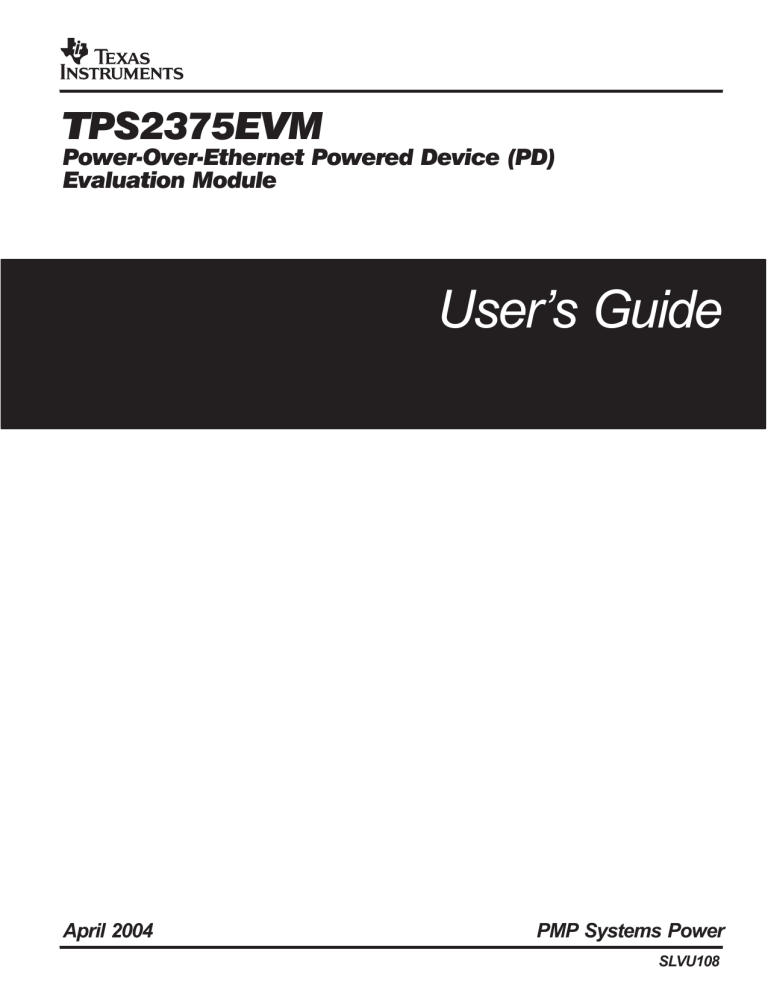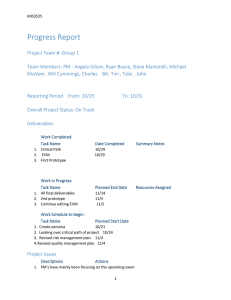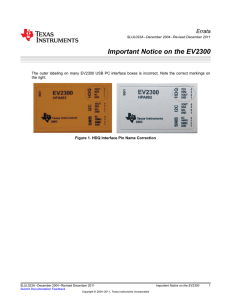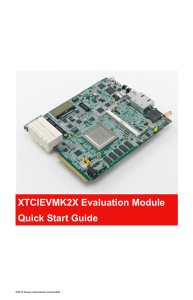
User’s Guide April 2004 PMP Systems Power SLVU108 IMPORTANT NOTICE Texas Instruments Incorporated and its subsidiaries (TI) reserve the right to make corrections, modifications, enhancements, improvements, and other changes to its products and services at any time and to discontinue any product or service without notice. Customers should obtain the latest relevant information before placing orders and should verify that such information is current and complete. All products are sold subject to TI’s terms and conditions of sale supplied at the time of order acknowledgment. TI warrants performance of its hardware products to the specifications applicable at the time of sale in accordance with TI’s standard warranty. Testing and other quality control techniques are used to the extent TI deems necessary to support this warranty. Except where mandated by government requirements, testing of all parameters of each product is not necessarily performed. TI assumes no liability for applications assistance or customer product design. Customers are responsible for their products and applications using TI components. To minimize the risks associated with customer products and applications, customers should provide adequate design and operating safeguards. TI does not warrant or represent that any license, either express or implied, is granted under any TI patent right, copyright, mask work right, or other TI intellectual property right relating to any combination, machine, or process in which TI products or services are used. Information published by TI regarding third-party products or services does not constitute a license from TI to use such products or services or a warranty or endorsement thereof. Use of such information may require a license from a third party under the patents or other intellectual property of the third party, or a license from TI under the patents or other intellectual property of TI. Reproduction of information in TI data books or data sheets is permissible only if reproduction is without alteration and is accompanied by all associated warranties, conditions, limitations, and notices. Reproduction of this information with alteration is an unfair and deceptive business practice. TI is not responsible or liable for such altered documentation. Resale of TI products or services with statements different from or beyond the parameters stated by TI for that product or service voids all express and any implied warranties for the associated TI product or service and is an unfair and deceptive business practice. TI is not responsible or liable for any such statements. Following are URLs where you can obtain information on other Texas Instruments products and application solutions: Products Applications Amplifiers amplifier.ti.com Audio www.ti.com/audio Data Converters dataconverter.ti.com Automotive www.ti.com/automotive DSP dsp.ti.com Broadband www.ti.com/broadband Interface interface.ti.com Digital Control www.ti.com/digitalcontrol Logic logic.ti.com Military www.ti.com/military Power Mgmt power.ti.com Optical Networking www.ti.com/opticalnetwork Microcontrollers microcontroller.ti.com Security www.ti.com/security Telephony www.ti.com/telephony Video & Imaging www.ti.com/video Wireless www.ti.com/wireless Mailing Address: Texas Instruments Post Office Box 655303 Dallas, Texas 75265 Copyright 2004, Texas Instruments Incorporated EVM IMPORTANT NOTICE Texas Instruments (TI) provides the enclosed product(s) under the following conditions: This evaluation kit being sold by TI is intended for use for ENGINEERING DEVELOPMENT OR EVALUATION PURPOSES ONLY and is not considered by TI to be fit for commercial use. As such, the goods being provided may not be complete in terms of required design-, marketing-, and/or manufacturing-related protective considerations, including product safety measures typically found in the end product incorporating the goods. As a prototype, this product does not fall within the scope of the European Union directive on electromagnetic compatibility and therefore may not meet the technical requirements of the directive. Should this evaluation kit not meet the specifications indicated in the EVM User’s Guide, the kit may be returned within 30 days from the date of delivery for a full refund. THE FOREGOING WARRANTY IS THE EXCLUSIVE WARRANTY MADE BY SELLER TO BUYER AND IS IN LIEU OF ALL OTHER WARRANTIES, EXPRESSED, IMPLIED, OR STATUTORY, INCLUDING ANY WARRANTY OF MERCHANTABILITY OR FITNESS FOR ANY PARTICULAR PURPOSE. The user assumes all responsibility and liability for proper and safe handling of the goods. Further, the user indemnifies TI from all claims arising from the handling or use of the goods. Please be aware that the products received may not be regulatory compliant or agency certified (FCC, UL, CE, etc.). Due to the open construction of the product, it is the user’s responsibility to take any and all appropriate precautions with regard to electrostatic discharge. EXCEPT TO THE EXTENT OF THE INDEMNITY SET FORTH ABOVE, NEITHER PARTY SHALL BE LIABLE TO THE OTHER FOR ANY INDIRECT, SPECIAL, INCIDENTAL, OR CONSEQUENTIAL DAMAGES. TI currently deals with a variety of customers for products, and therefore our arrangement with the user is not exclusive. TI assumes no liability for applications assistance, customer product design, software performance, or infringement of patents or services described herein. Please read the EVM User’s Guide and, specifically, the EVM Warnings and Restrictions notice in the EVM User’s Guide prior to handling the product. This notice contains important safety information about temperatures and voltages. For further safety concerns, please contact the TI application engineer. Persons handling the product must have electronics training and observe good laboratory practice standards. No license is granted under any patent right or other intellectual property right of TI covering or relating to any machine, process, or combination in which such TI products or services might be or are used. Mailing Address: Texas Instruments Post Office Box 655303 Dallas, Texas 75265 Copyright 2004, Texas Instruments Incorporated EVM WARNINGS AND RESTRICTIONS It is important to operate this EVM within the input voltage range of 0 V and 57 V and the output voltage range of 0 V and 57 V. Exceeding the specified input range may cause unexpected operation and/or irreversible damage to the EVM. If there are questions concerning the input range, please contact a TI field representative prior to connecting the input power. Applying loads outside of the specified output range may result in unintended operation and/or possible permanent damage to the EVM. Please consult the EVM User’s Guide prior to connecting any load to the EVM output. If there is uncertainty as to the load specification, please contact a TI field representative. During normal operation, some circuit components may have case temperatures greater than 85°C. The EVM is designed to operate properly with certain components above 85°C as long as the input and output ranges are maintained. These components include but are not limited to linear regulators, switching transistors, pass transistors, and current sense resistors. These types of devices can be identified using the EVM schematic located in the EVM User’s Guide. When placing measurement probes near these devices during operation, please be aware that these devices may be very warm to the touch. Mailing Address: Texas Instruments Post Office Box 655303 Dallas, Texas 75265 Copyright 2004, Texas Instruments Incorporated Information About Cautions and Warnings Preface About This Manual This user’s guide describes the TPS2375 HPA028 evaluation module (EVM). It contains the EVM schematic, bill of materials, assembly drawing, and top and bottom board layouts. How to Use This Manual This document contains the following chapters: - Chapter 1 — Introduction - Chapter 2 — Hardware Overview - Chapter 3 — EVM Operation - Chapter 4 — Bill of Materials - Chapter 5 — EVM Schematic and Layout Information About Cautions and Warnings This book may contain cautions and warnings. This is an example of a caution statement. A caution statement describes a situation that could potentially damage your software or equipment. This is an example of a warning statement. A warning statement describes a situation that could potentially cause harm to you. v Related Documentation From Texas Instruments The information in a caution or a warning is provided for your protection. Please read each caution and warning carefully. Related Documentation From Texas Instruments TPS2375 Power Over Ethernet Powered Device Power Switch − data sheet, (SLUSxxx). vi Contents 1 Introduction . . . . . . . . . . . . . . . . . . . . . . . . . . . . . . . . . . . . . . . . . . . . . . . . . . . . . . . . . . . . . . . . . . . . . 1-1 2 Hardware Overview . . . . . . . . . . . . . . . . . . . . . . . . . . . . . . . . . . . . . . . . . . . . . . . . . . . . . . . . . . . . . . 2-1 3 EVM Operation . . . . . . . . . . . . . . . . . . . . . . . . . . . . . . . . . . . . . . . . . . . . . . . . . . . . . . . . . . . . . . . . . . 3.1 Setup . . . . . . . . . . . . . . . . . . . . . . . . . . . . . . . . . . . . . . . . . . . . . . . . . . . . . . . . . . . . . . . . . . . . . 3.2 Jumpers . . . . . . . . . . . . . . . . . . . . . . . . . . . . . . . . . . . . . . . . . . . . . . . . . . . . . . . . . . . . . . . . . . . 3.3 Test Points . . . . . . . . . . . . . . . . . . . . . . . . . . . . . . . . . . . . . . . . . . . . . . . . . . . . . . . . . . . . . . . . . 3.4 Features . . . . . . . . . . . . . . . . . . . . . . . . . . . . . . . . . . . . . . . . . . . . . . . . . . . . . . . . . . . . . . . . . . 3.4.1 Input and Output Capacitors . . . . . . . . . . . . . . . . . . . . . . . . . . . . . . . . . . . . . . . . . . 3.4.2 Gigabit Ethernet Application . . . . . . . . . . . . . . . . . . . . . . . . . . . . . . . . . . . . . . . . . . 3.4.3 Dual DUT Footprint . . . . . . . . . . . . . . . . . . . . . . . . . . . . . . . . . . . . . . . . . . . . . . . . . . 3.4.4 Power-Good Indicator . . . . . . . . . . . . . . . . . . . . . . . . . . . . . . . . . . . . . . . . . . . . . . . . 3.4.5 Connect DC/DC Converter . . . . . . . . . . . . . . . . . . . . . . . . . . . . . . . . . . . . . . . . . . . . 3.4.6 Available Spare Footprints . . . . . . . . . . . . . . . . . . . . . . . . . . . . . . . . . . . . . . . . . . . . 4 Bill of Materials . . . . . . . . . . . . . . . . . . . . . . . . . . . . . . . . . . . . . . . . . . . . . . . . . . . . . . . . . . . . . . . . . . 4-1 4.1 Bill of Materials . . . . . . . . . . . . . . . . . . . . . . . . . . . . . . . . . . . . . . . . . . . . . . . . . . . . . . . . . . . . . 4-2 5 Schematic and Layout . . . . . . . . . . . . . . . . . . . . . . . . . . . . . . . . . . . . . . . . . . . . . . . . . . . . . . . . . . . 5-1 5.1 TPS2375 EVM Schematic . . . . . . . . . . . . . . . . . . . . . . . . . . . . . . . . . . . . . . . . . . . . . . . . . . . 5-2 5.2 Layouts . . . . . . . . . . . . . . . . . . . . . . . . . . . . . . . . . . . . . . . . . . . . . . . . . . . . . . . . . . . . . . . . . . . 5-3 3-1 3-2 3-2 3-2 3-3 3-3 3-3 3-3 3-3 3-3 3-4 5−1 5−2 Top Assembly Layer . . . . . . . . . . . . . . . . . . . . . . . . . . . . . . . . . . . . . . . . . . . . . . . . . . . . . . . . . . . 5-4 Bottom Assembly Layer . . . . . . . . . . . . . . . . . . . . . . . . . . . . . . . . . . . . . . . . . . . . . . . . . . . . . . . . 5-5 vii Contents viii Chapter 1 This User’s Guide describes the setup and operation of the TPS2375 HPA028 evaluation module (EVM). Information and instructions presented throughout this document assumes user familiarity with the IEEE 802.3af Specification for Power Over Ethernet. Introduction 1-1 (This page has been left blank intentionally.) 1-2 Chapter 2 The HPA028 EVM features the TPS2375 made by Texas Instruments Incorporated. The EVM is designed to look like the front end of any Power Over Ethernet (PoE) Powered Device (PD) module. An RJ-45 connector is provided to connect directly to an Ethernet cable having a Power Sourcing Equipment (PSE) driving it on the other end. The EVM also accepts power applied using a stand-alone power supply. According to the IEEE 802.3af specification, the PD module must provide the circuitry needed to be detected by the PSE as it polls the Ethernet links. The IEEE 802.3af specification also allows the option for the PD to provide classification as to the amount of power needed by the PD Module. The HPA028 EVM with the TPS2375 provides all the necessary hardware to provide detection and classification. The HPA028 EVM also has connections for connecting an external DC/DC converter to convert the 48 V down to the voltages needed for the Ethernet Module. Hardware Overview 2-1 (This page has been left blank intentionally.) 2-2 Chapter 3 This chapter discusses the EVM operation including setup, jumpers, test points and features. Topic Page 3.1 Setup . . . . . . . . . . . . . . . . . . . . . . . . . . . . . . . . . . . . . . . . . . . . . . . . . . . . . . . . 3-2 3.2 Jumpers . . . . . . . . . . . . . . . . . . . . . . . . . . . . . . . . . . . . . . . . . . . . . . . . . . . . . 3-2 3.3 Test Points . . . . . . . . . . . . . . . . . . . . . . . . . . . . . . . . . . . . . . . . . . . . . . . . . . . 3-2 3.4 Features . . . . . . . . . . . . . . . . . . . . . . . . . . . . . . . . . . . . . . . . . . . . . . . . . . . . . 3-3 EVM Operation 3-1 Setup 3.1 Setup The HPA028 EVM is designed to allow evaluation of the TPS2375 device. Test points and jumpers are provided to facilitate testing and configuration. At the factory, JP0, JP5, JP6 (between pin 2 and pin 3), and JP7 will be installed. 3.2 Jumpers JP0, JP1, JP2, JP3, JP4 Selects the Classification Resistor JP5 Used to pass power from the input JP6 Selects ground connection when applying an external power supply on J4 or J5 JP7 Used to connect a 4.7 kΩ resistor as the load of the PD, that may be used to maintain the power signature for the PD 3.3 Test Points Test Points Description TP1 Test point for TPS2375 ILIM pin TP2 Test point for TPS2375 CLASS pin TP3 Test point for TPS2375 DET pin TP4 Test point for TPS2375 VSS pin TP5 Test point for TPS2375 RTN pin TP6 Test point for TPS2375 PG pin TP7 Test point for TPS2375 N/C pin (or the UVLO pin if the DUT is TPS2376) TP8 Test point for TPS2375 VDD pin TP9 Test point for the 48 volts after the diode-bridges (BRG1 and BRG2) TP10 Test point for the 48-V return on the Power Sourcing Equipment side TP11, TP12 Test point for probing the signal-pair 48-V inputs coming from the RJ-45 connector or for connecting an external 48-V power supply. TP13, TP14 Test point for probing the spare pair 48-V inputs coming from the RJ-45 connector or for connecting an external 48V power supply TP15, TP16, TP17 Test points (only TP17 installed) for probing the 48-V supply to the load (DC/DC Converter), or for connecting additional load resistors or capacitors TP18, TP19, TP20 Test points (only TP20 installed) for probing the 48-V RTN or for connecting additional load resistors or capacitors 3-2 Features 3.4 Features The HPA028 EVM facilitates easy evaluation of the TPS2375 PD controller. The EVM features are described in this section. 3.4.1 Input and Output Capacitors The input capacitor of the TPS2375 PD controller is specified by the IEEE802.3af standard. C1, a 0.1 µF ±10% ceramic capacitor, meets the IEEE specification, so no additional input capacitor can be added. Two spare capacitor footprints (C2 and C4) on the EVM are provided for adding additional load capacitance on the output of the TPS2375. When adding any of the large aluminum electrolytic capacitors, care should be taken to select capacitors with an appropriate voltage rating, and to observe the polarity marking on the PCB silkscreen. The recommended voltage rating for these capacitors is 100 V. 3.4.2 Gigabit Ethernet Application The EVM only allows 10/100BASE data rate transmission due to the magnetic limitation of T1 (H2019). To evaluate the EVM with a Gigabit Ethernet network, remove T1 (H2019), R13, R14, R15, and R16, and place a Gigabit transformer (H5007) on the T2 footprint. 3.4.3 Dual DUT Footprint Since the TPS2375 is available in both SO-8 and TSSOP-8 packages, two footprints (U1 and U2) are provided to test either package. The EVM is supplied with the SO-8 package device (TPS2375D) on the U2 footprint. To evaluate the TSSOP package, remove the device from U2 and solder a TSSOP-8 package device (TPS2375PW) on the U1 footprint. Warning Do not have devices on both U1 and U2 at the same time. 3.4.4 Power-Good Indicator The PG LED (D3) Indicator illuminates when the TPS2375 turns on. 3.4.5 Connect DC/DC Converter A block connector (J2) is provided to connect downstream DC/DC converters if desired. Test points (such as TP17 and TPS20) are not recommended for connecting loads. EVM Operation 3-3 Features 3.4.6 Available Spare Footprints - TP15, TP16 – extra test points for 48-V positive rail (VDD) - TP18, TP19 − extra test points for 48-V load-side return (RTN) - J5 – Jack for connecting an external wall-mounted transformer power sup- ply; - R8, R9 – To set the UVLO threshold if a TPS2376 is under test; - R12 – To reduce the load resistance (or increase the load current) on the TPS2375 output if desired. 3-4 Chapter 4 This chapter contains the bill of materials for the TPS2375EVM. Topic 4.1 Page Bill of Materials . . . . . . . . . . . . . . . . . . . . . . . . . . . . . . . . . . . . . . . . . . . . . . . 4-2 Bill of Materials 4-1 Bill of Materials 4.1 Bill of Materials Count 4-2 RefDes Description Size Part Number MFR 1 D1 Diode, 58-V TVS, SMA SMAJ58A Vishay 1 D2 Diode, 5.6 V Zener D0−219AB BZD27C5V6P Vishay 1 D3 LED, SMD, Green, PLCC2−Package 1210 TLMG3102 Vishay 3 D4, D5, D6 Bridge Rectifier, 100 V, 1A, SMD DF−S DF01S Vishay 1 C1 Capacitor, 0.1 µF,100-V, X7R, 10% 1210 VJ1210Y104KXBXX Vishay 1 C3 Capacitor33−µF, 100-V, 20% TH 2222 038 59339 Vishay 0 C2, C4 Capacitor33−µF, 100-V, 20% TH 2222 038 59339 Vishay 2 J1, J3 Connector, Jack, Modular, 8 POS 0.705 × 0.82 520252 AMP 1 J2 Terminal Block, 6 pin, 10-A, 200 mil space 1.225 × 0.401 999394 Weidmuller 1 J4 Header, 2−pin, 100 mil spacing PTC36SAAN Sullins 0 J5 Connector, 2.1 mm, DC Jack w/ Switch, SM RASM 722 Switchcraft 7 JP0, JP1, JP2, JP3, JP4, JP5, JP7 Header, 2−pin, 100 mil spacing PTC36SAAN Sullins 1 JP6 Header, 3−pin, 100mil spacing PTC36SAAN Sullins 1 Q1 MOSFET, N−ch, 60−V, 115−mA, 1.2 Ω SOT23 2N7002 E Vishay 1 R0 Resistor, Chip, 4.42K Ω, 1/16−W, 1% 603 CRCW06034421F Vishay 1 R1 Resistor, Chip, 95 Ω, 1/8W, 1% 1206 CRCW1206953F Vishay 1 R2 Resistor, Chip, 549 Ω, 1/8W, 1% 1206 CRCW1206549F Vishay 1 R3 Resistor, Chip, 357 Ω, ½ W, 1% 2010 CRCW20103570F Vishay 1 R4 Resistor, Chip, 255 Ω, ½ W, 1% 2010 CRCW20102550F Vishay 1 R5 Resistor, Chip, 24.9 KΩ, 1/10−W, 1% 805 CRCW08052492F Vishay 1 R6 Resistor, Chip, 178 KΩ, 1/10−W, 1% 805 Std Std 1 R7 Resistor, Chip, 100 KΩ, 1/10−W,5% 805 CRCW08051003J Vishay 0 R8 Resistor, Chip, 138 KΩ, 1/10W, 5% 805 CRCW0805−xxx−J Vishay 0 R9 Resistor, Chip, 10 KΩ, 1/10W, 5% 805 CRCW0805−xxx−J Vishay 1 R10 Resistor, Chip, 20 KΩ, 1/8−W, 5% 1206 Std Std 1 R11 Resistor, Chip, 4.7 KΩ, 1−W, 1% 2512 WSL−2512−4701 1% Vishay 0 R12 Resistor, Chip, xx Ω, 1−W, 1% 2512 WSL−2512−xx 1% Vishay 4 R13, R14, R15, R16 Resistor, Chip, 0 Ω, 1/16−W, x% 402 Std Std 1 T1 16−PIN SOIC Xfmr, Center−tapped, 16−SOIC H2019 Pulse 0 T2 24−pin SOIC Magnetics Modules, Ratio 1:1 SO24 H5007 Pulse 12 TP1, TP2, TP3, TP6, TP7, TP8, TP9, TP11, TP12, TP13, TP14, TP17 Test Point, Red, 1 mm 0.038 07WX9455 Farnell 0 TP15, TP16 Test Point, Red, 1 mm 0.038 07WX9455 Farnell 4 TP4,TP5, TP10, TP20 Test Point, Black, 1 mm 0.038 240−333 Farnell 0 TP18, TP19 Test Point, Black, 1 mm 0.038 240−333 Farnell 0.57 × 0.35 Bill of Materials Count RefDes Description Size Part Number MFR 0 U1 IC, TPS2375 Powered Device Controller TSSOP−8 TPS2375PW TI 1 U2 IC, TPS2375 Powered Device Controller SO−8 TPS2375D TI 4 Shunt on JP0,JP5, JP6, & JP7, 2−pin, 0.100 cntr STC02SYAN Sullins 1 −− PCB, 4.316 In × 2.890 In × 0.062 In HPA028 Any Rubber bumber 2566 SPC Tech. 4 Notes: 1) These assemblies are ESD sensitive, ESD precautions must be observed. 2) These assemblies must be clean and free from flux and all contaminants. Use of no clean flux is not acceptable. 3) These assemblies must comply with workmanship standards IPC−A−610 Class 2. 4) Reference designators marked with an asterisk (**) cannot be substituted. All other components can be substitutedwith equivalent MFG’s components. Bill of Materials 4-3 4-4 Chapter 5 ! "# This chapter contains the schematic and layout for the TPS2375EVM. Topic Page 5.1 Schematic . . . . . . . . . . . . . . . . . . . . . . . . . . . . . . . . . . . . . . . . . . . . . . . . . . . . 5-2 5.2 Layouts . . . . . . . . . . . . . . . . . . . . . . . . . . . . . . . . . . . . . . . . . . . . . . . . . . . . . . 5-3 Schematic and Layout 5-1 TPS2375 EVM Schematic 5.1 TPS2375 EVM Schematic 5-2 Layouts 5.2 Layouts The board layout is shown on the following pages. Schematic and Layout 5-3 Layouts Figure 5−1. Top Assembly Layer 5-4 Layouts Figure 5−2. Bottom Assembly Layer Schematic and Layout 5-5 5-6




